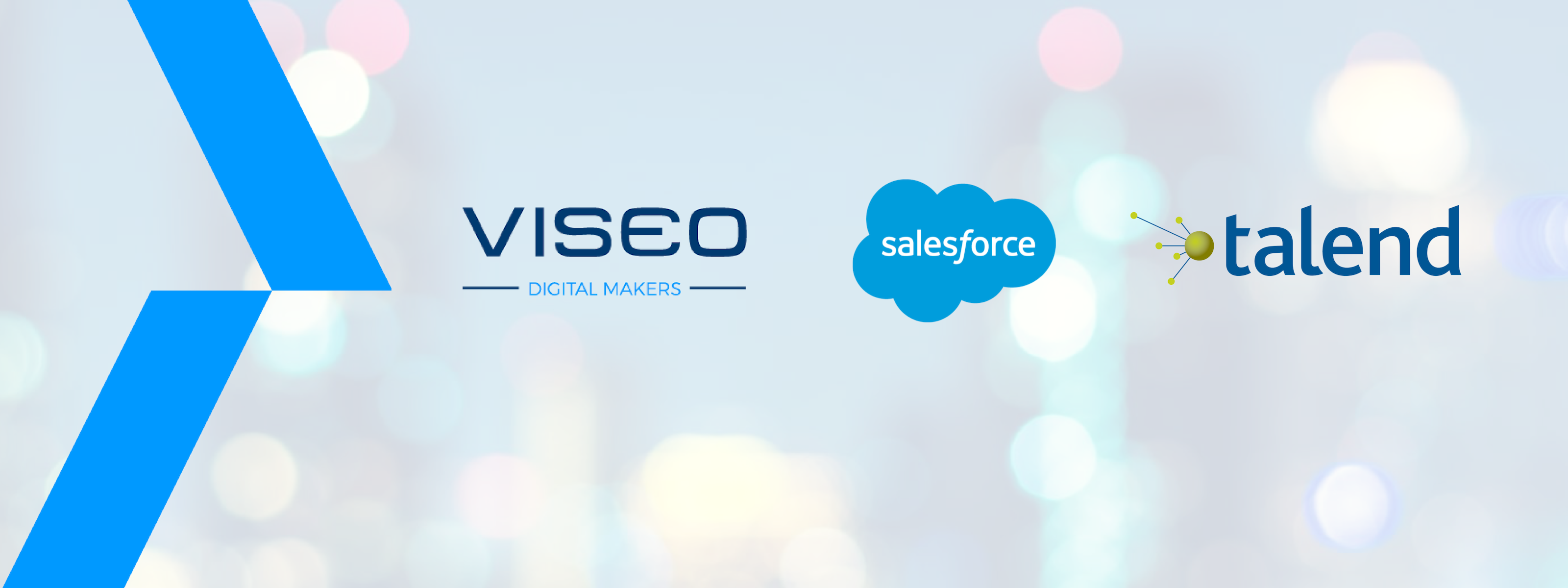EXPERTISE
Improve the quality of your customer data in Salesforce with Talend
On Friday, March 9, 2018, VISEO & Talend organized a morning session on the theme of improving data quality in Salesforce with Talend. We present you the report of this event.
VISEO & Talend, partners for 8 years, co-organized on March 9, 2018 a morning dedicated to the solutions proposed by Talend for Salesforce during which Yves Cointrelle, Director Data and Analytics VISEO ; Guillaume David, VISEO Data Management Consultant & Jérôme Elek, Talend Pre-Sales Consultant, spoke. We suggest you come back to this event.
What can be done with Salesforce and Talend data? How VISEO can help you?
VISEO plays a key role between Talend & Salesforce through its ability to bring together Salesforce and Data skills in an end-to-end project management approach.
Talend enables the overall cohesion of an Information System through the exchange processes between external data sources and applications or ERPs such as SAP and Salesforce. "Talend's business is to offer solutions that enhance data reliability and value".
Talend values data in all its forms: "Our job is to value the company's data," explains Jérôme Elek, Talend pre-sales consultant. Naturally, we brought this traditional capacity to the Big Data world and today we are a major player in this field since we are able to process much larger volumes of information - data from social networks, industry, IoT...".
From On-premise to the Cloud
Talend is able to offer On-premise and Cloud software solutions." It is by accompanying our customers, who have increase their Cloud vision and orientation, that we have naturally come to this change," Jérôme says.
Today, thanks to Talend, customers can address different types of cases:
• Data extracted on-premise from local ERP or applications
• Hybrid with SAAS-based applications hosted outside the enterprise such as Salesforce
• Extended systems offered by the Cloud by connecting to Google, Azure or Amazon Cloud.
4 use cases on Salesforce data processing with Talend Cloud were illustrated through an in-depth demonstration:
1. Analyze data present in Salesforce and identify anomalies in order to correct them (recovery):
Talend makes it easier to detect anomalies through a quality diagnosis, but also to correct them. The Data Preparation tool allows both profiling and recovery.
Two parts are to be considered: the data set part which consists in searching a sample of the data in the company, to flag them and to qualify them. The second step is to manipulate this data.
"What is interesting about Data Preparation is that the user will really be able to access the data in real time," explains Jérôme.
If a change is made in Salesforce, Data Preparation will take it directly into account, eliminating the need for IT, Excel exports, etc.".
In terms of data quality, Data preparation offers a semantic dictionary that makes it possible to cross a column and a semantic title. This semantic dictionary is not closed, it can be enriched (product references, factories...). Crossing the files will automatically generate quality indicators.
For further data quality analysis, the Talend Data Stewardship tool described below should be used.
2. Detect duplicate anomalies
Talend Data Stewardship provides rapid identification, management and resolution of data integrity issues such as duplicates, based on pre-analysis.
It also generates "out-of-the-box" jobs that separate single and duplicate records. These jobs output all duplicates to a specific file and write the unique values to the targeted database in the analysis. The tool is thus able to detect duplicates but also potential cases of duplicates.
3. Automatically integrate external or open-data data within Salesforce
Talend's ability to integrate external data, particularly open Data, enables it to enrich existing data by adding a Siret (business identification number) to a company where only the name and address are available.
4. Make migrations from an existing (CRM or ERP) to Salesforce
Talend's tools allow information to be retrieved and positioned in a staging tool where users can work on the data before injecting it into Salesforce. This allows them to migrate (for example from SAP CRM to Salesforce) by limiting the number of trips and avoiding the need to go through Excel files.


